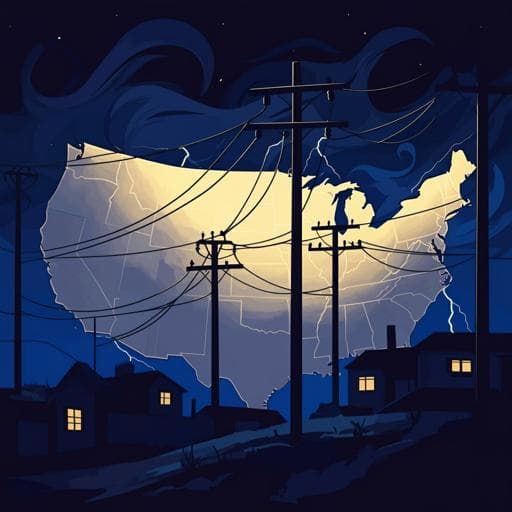
Environmental Studies and Forestry
Spatiotemporal distribution of power outages with climate events and social vulnerability in the USA
V. Do, H. Mcbrien, et al.
This study reveals the significant impact of power outages in the US from 2018 to 2020, highlighting that over 520 million customer-hours were lost annually. Unpacking the effects of extreme weather and social vulnerability, this research by Vivian Do, Heather McBrien, Nina M. Flores, Alexander J. Northrop, Jeffrey Schlegelmilch, Mathew V. Kiang, and Joan A. Casey is essential for enhancing disaster preparedness and resource allocation strategies.
~3 min • Beginner • English
Introduction
Power outages are expected to rise as climate change intensifies, the grid ages, and energy demand grows. Outages harm health via carbon monoxide poisoning from generators, stress, exacerbations of cardiovascular and respiratory disease, and temperature-related illnesses during extremes. Vulnerable populations include users of electricity-dependent durable medical equipment (DME), under-resourced and historically marginalized communities, and areas with older housing and higher chronic disease burden. Prior health studies often proxy outage exposure using disaster timing/locations, and there has been no national, high-resolution outage dataset suitable for health research. This study develops relative and absolute county-level metrics of power outages across the United States (2018–2020), characterizes their spatiotemporal distribution, quantifies co-occurrence with severe weather and climate events, and assesses overlap with social and medical vulnerability.
Literature Review
Large-scale outages (50,000+ customers or 300 MW loss) in the US are predominantly weather-driven, with storms causing 83% from 2000–2021. Prior work largely analyzed single disasters (e.g., Hurricanes Sandy, Irma) or state-level summaries (EIA, DOE OE-417), limiting insight into smaller yet frequent county-level outages. Environmental justice research documents disproportionate environmental exposures among low-income and communities of color, and energy justice studies suggest disparities in outage durations and restoration (e.g., Puerto Rico after Hurricane Maria; Florida after Irma; Texas 2021). However, nationwide sub-state analyses linking outages, climate events, and vulnerability have been scarce. This study fills that gap by leveraging commercial outage data to produce sub-state metrics and by integrating CDC’s Social Vulnerability Index (SVI) and HHS emPOWER DME metrics.
Methodology
Data: Purchased 10-minute resolution outage data (customers without power and timestamp) from PowerOutage.us for 2018–2020 (2017 excluded for low coverage). Outage reports are aggregated from utility APIs at sub-county levels. Coverage summary used EIA utility data; dataset captured 59.4% of cooperatives and 84.4% of investor-owned utilities. Counties were retained after reliability checks: API reporting ≥50% of the time and customer coverage ≥50% of total county customers. This yielded 2447 counties (73.7% of US population), with most analyses on 2038 counties with ≥2 reliable years; a subset of 1653 continental counties with 3 reliable years was used for weather co-occurrence analyses.
Outage event definition (relative metric): For each county-hour, an outage event occurred when ≥0.1% of county customers were without power (threshold chosen as the county-level 90th percentile of customers out per hour). Duration was the continuous time the threshold was met or exceeded. Two event durations were summarized: 1+ hour and 8+ hours (medically relevant). Annual average counts per county (2018–2020) were computed (analogous to SAIFI).
Outage experience (absolute metrics): (1) Annual average total customer-hours without power per county; (2) Annual average minutes without power per customer (analogous to SAIDI).
Severe weather and climate events: Daily county-level indicators for anomalous heat/cold (relative to 1981–2010 weekly percentiles; heat >24°C and >85th percentile; cold <0°C and <15th percentile), heavy precipitation (>85th percentile), snowfall (≥2.54 cm), lightning (any flash), tropical cyclones (county within 100 km of track center), and wildfires (county intersecting a ≥21 km² fire), sourced from PRISM, National Gridded Snowfall Analysis, ISS Lightning Imaging Sensor, IBTrACS, and NIFC. County-days were categorized as isolated single-event or multiple events.
Vulnerability metrics: County-level SVI (CDC/ATSDR; 16 ACS variables, composite 0–1; analyzed in quartiles) and prevalence of Medicare DME users per 1000 Medicare beneficiaries (HHS emPOWER; December 2020; quartiles).
Statistical analysis: Descriptive summaries for outage counts and customer-hours. Weather co-occurrence analysis identified county-days when an 8+ hour outage began and whether severe weather/climate events occurred the same day; computed co-occurrence ratios relative to days with no event. Wilcoxon Rank Sum tests compared annual average 8+ hour outage counts across SVI and DME quartiles (n=2038). Bivariate Local Indicators of Spatial Association (LISA) identified clusters of counties with simultaneously high 8+ hour outage counts and high SVI or high DME prevalence; 99,999 permutations, two-sided tests, α=0.05 with false discovery rate correction (rgeoda). Mapping used usmap; analyses in R 4.1.0.
Key Findings
- Scope and frequency: 2447 counties (77.9% of US counties) included; 2038 (83.3%) had ≥2 reliable years (2018–2020). Median annual county-level counts: 60 (IQR 97) for 1+ hour outages and 2 (IQR 5) for 8+ hour outages. Over 70% of counties experienced at least one 8+ hour outage. Total events (2018–2020): 231,174 1+ hour outages; 17,484 8+ hour outages. 8+ hour outages peaked late spring and mid-summer, typically starting around 6 PM (3–8 PM range; pronounced in the South).
- Geography: Highest average 8+ hour outage counts in the South, Maine, Michigan, and Appalachia. Top states by annual average 8+ hour outages: Louisiana (553), Texas (527), Michigan (447), Mississippi (381), North Carolina (372). For 1+ hour outages: Texas (11,504), Georgia (10,609), Louisiana (7826), Mississippi (7188), Alabama (6240). Counties with top outage deciles concentrated in Michigan and Louisiana (8+ hr), and in Texas, Louisiana, Mississippi (1+ hr).
- Absolute burden: Across 2447 counties, outages averaged 5.2 million customer-hours without power annually. States with highest annual average customer-hours out: Louisiana (>52 million), North Carolina (38.3M), California (30.3M), Texas (30.0M), New York (28.8M). Top counties by annual average customer-hours out: Calcasieu, LA (10.0M), Los Angeles, CA (7.8M), Fairfield, CT (7.6M), Davidson, TN (7.4M), Jefferson, LA (6.2M). Highest annual average hours without power per customer clustered along the Gulf Coast and Northeast (notably Maine); Orleans, NY averaged 251.4 hours per customer per year.
- Weather/climate co-occurrence (n=1653 counties with 3 years): 22,793 county-days had an 8+ hour outage; 62.1% co-occurred with ≥1 severe weather/climate event. 8+ hour outages were 3.4 times more common on isolated-event days and 10 times more common on multiple-event days vs. no-event days. Event-specific co-occurrence ratios: heavy precipitation 4.7x (37.3% of outage days), snowfall 6.7x (5.1%), anomalous heat 1.2x (4.8%), anomalous cold 0.9x (1.5%), wildfire 2.3x (0.4%), lightning 2.6x (0.3%), tropical cyclone 13.7x (0.2%). Multiple-event combinations with highest ratios included heavy precipitation + cyclone (37.5x; 3.0% of outage days) and heavy precipitation + cyclone + anomalous heat (51.6x; 0.4%). Seasonal patterns: heavy precipitation and snowfall dominant in winter; anomalous heat in summer; tropical cyclones and wildfires July–November; regional variation with wildfires prominent in the West in Sep–Oct.
- Vulnerability: Counties in highest SVI quartile had higher median annual outages (1+ hr: 80 vs. 40; 8+ hr: 3 vs. 1) than lowest SVI quartile (Wilcoxon p<0.01). DME prevalence highest quartile had lower median annual outages (1+ hr: 42; 8+ hr: 1) than other quartiles (p<0.01), despite high susceptibility to outage impacts. Bivariate LISA identified 63 counties in 7 states with high-high clusters (high SVI and high 8+ hr outages), concentrated in Louisiana (n=26), Mississippi (n=12), Arkansas (n=9), and Michigan (n=8). High SVI-high outage counties had higher percentages of racial/ethnic minority residents (40.4% vs 24.0%), residents below 150% poverty (34.0% vs 24.3%), and mobile homes (20.1% vs 12.4%) (p<0.05). For DME, 38 counties in 8 states were high-high (notably Arkansas n=12, Michigan n=10, Louisiana n=9).
Discussion
By constructing county-level relative and absolute outage metrics, this study provides the first comprehensive sub-state national portrait of power outage exposure relevant to public health. Findings show that medically relevant 8+ hour outages are frequent across much of the South, Northeast, and Appalachia, often beginning during peak demand hours. Most 8+ hour outages co-occur with severe weather or climate events—particularly heavy precipitation, snowfall (winter), anomalous heat (summer), and tropical cyclones—highlighting climate sensitivity of outage risk. Identifying high co-occurrence ratios for specific event combinations (e.g., heavy precipitation with tropical cyclones) informs targeted preparedness and infrastructure hardening.
The overlap of high outage burden with high social vulnerability indicates potential inequities in exposure and capacity to cope, emphasizing the need to integrate social vulnerability into preparedness, response, and grid investment decisions. While nearly 40% of 8+ hour outage days did not coincide with the examined events, likely reflecting technical failures and grid aging, these results underscore the dual roles of climate hazards and infrastructure resilience in outage risk. The absolute (customer-hours) and relative (event counts per county) metrics together can guide health studies, emergency planning, and equitable resource allocation, including prioritizing communities with high SVI or high DME prevalence that face compounding risks.
Conclusion
This work delivers county-level relative and absolute metrics of power outages across the US (2018–2020), links outages to severe weather and climate events, and maps co-occurrence with social and medical vulnerability. It documents substantial outage burdens, strong climate-event associations, and clusters of high outage exposure in socially vulnerable areas. These metrics can support epidemiologic research, inform equitable disaster preparedness and response, and guide infrastructure planning in a changing climate. Future research should employ finer spatiotemporal resolution (e.g., sub-county, household/building), leverage improved utility data or sensors/satellite imagery, and analyze cause-specific outages to quantify causal links with weather/climate hazards and evaluate mitigation strategies that incorporate social vulnerability into grid investments.
Limitations
- Incomplete utility coverage: Not all US utilities are included in PowerOutage.us (small rural utilities often absent); 563 counties lacked reliable data, concentrated in the Midwest and Mountain West.
- Temporal scope: Only three years (2018–2020), limiting assessment of long-term trends.
- Spatial aggregation: County-level measures may mask sub-county heterogeneity; outage events could reflect dispersed minor outages or a single large localized outage.
- Exposure definition: The 0.1% customer threshold identifies events, but the composition of customers without power during an event can change over time; 1+ hr and 8+ hr outages may not involve the same customers.
- Weather linkage: Co-occurrence on the same day does not establish causality between events and outages; lack of cause-specific outage data.
- Vulnerability metrics: SVI is comprehensive but not outage-specific; county-level SVI and DME measures may obscure finer-scale patterns. DME prevalence (emPOWER) covers Medicare beneficiaries and may undercount total DME users.
Related Publications
Explore these studies to deepen your understanding of the subject.







